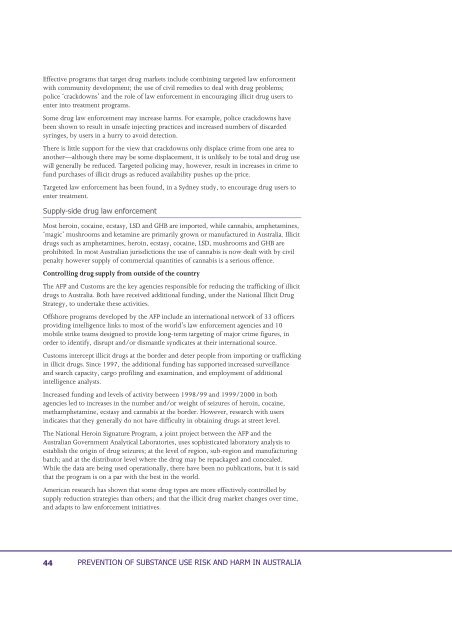Summary - Department of Health and Ageing
Summary - Department of Health and Ageing
Summary - Department of Health and Ageing
Create successful ePaper yourself
Turn your PDF publications into a flip-book with our unique Google optimized e-Paper software.
Effective programs that target drug markets include combining targeted law enforcement<br />
with community development; the use <strong>of</strong> civil remedies to deal with drug problems;<br />
police ‘crackdowns’ <strong>and</strong> the role <strong>of</strong> law enforcement in encouraging illicit drug users to<br />
enter into treatment programs.<br />
Some drug law enforcement may increase harms. For example, police crackdowns have<br />
been shown to result in unsafe injecting practices <strong>and</strong> increased numbers <strong>of</strong> discarded<br />
syringes, by users in a hurry to avoid detection.<br />
There is little support for the view that crackdowns only displace crime from one area to<br />
another—although there may be some displacement, it is unlikely to be total <strong>and</strong> drug use<br />
will generally be reduced. Targeted policing may, however, result in increases in crime to<br />
fund purchases <strong>of</strong> illicit drugs as reduced availability pushes up the price.<br />
Targeted law enforcement has been found, in a Sydney study, to encourage drug users to<br />
enter treatment.<br />
<br />
Most heroin, cocaine, ecstasy, LSD <strong>and</strong> GHB are imported, while cannabis, amphetamines,<br />
‘magic’ mushrooms <strong>and</strong> ketamine are primarily grown or manufactured in Australia. Illicit<br />
drugs such as amphetamines, heroin, ecstasy, cocaine, LSD, mushrooms <strong>and</strong> GHB are<br />
prohibited. In most Australian jurisdictions the use <strong>of</strong> cannabis is now dealt with by civil<br />
penalty however supply <strong>of</strong> commercial quantities <strong>of</strong> cannabis is a serious <strong>of</strong>fence.<br />
Controlling drug supply from outside <strong>of</strong> the country<br />
The AFP <strong>and</strong> Customs are the key agencies responsible for reducing the trafficking <strong>of</strong> illicit<br />
drugs to Australia. Both have received additional funding, under the National Illicit Drug<br />
Strategy, to undertake these activities.<br />
Offshore programs developed by the AFP include an international network <strong>of</strong> 33 <strong>of</strong>ficers<br />
providing intelligence links to most <strong>of</strong> the world’s law enforcement agencies <strong>and</strong> 10<br />
mobile strike teams designed to provide long-term targeting <strong>of</strong> major crime figures, in<br />
order to identify, disrupt <strong>and</strong>/or dismantle syndicates at their international source.<br />
Customs intercept illicit drugs at the border <strong>and</strong> deter people from importing or trafficking<br />
in illicit drugs. Since 1997, the additional funding has supported increased surveillance<br />
<strong>and</strong> search capacity, cargo pr<strong>of</strong>iling <strong>and</strong> examination, <strong>and</strong> employment <strong>of</strong> additional<br />
intelligence analysts.<br />
Increased funding <strong>and</strong> levels <strong>of</strong> activity between 1998/99 <strong>and</strong> 1999/2000 in both<br />
agencies led to increases in the number <strong>and</strong>/or weight <strong>of</strong> seizures <strong>of</strong> heroin, cocaine,<br />
methamphetamine, ecstasy <strong>and</strong> cannabis at the border. However, research with users<br />
indicates that they generally do not have difficulty in obtaining drugs at street level.<br />
The National Heroin Signature Program, a joint project between the AFP <strong>and</strong> the<br />
Australian Government Analytical Laboratories, uses sophisticated laboratory analysis to<br />
establish the origin <strong>of</strong> drug seizures; at the level <strong>of</strong> region, sub-region <strong>and</strong> manufacturing<br />
batch; <strong>and</strong> at the distributor level where the drug may be repackaged <strong>and</strong> concealed.<br />
While the data are being used operationally, there have been no publications, but it is said<br />
that the program is on a par with the best in the world.<br />
American research has shown that some drug types are more effectively controlled by<br />
supply reduction strategies than others; <strong>and</strong> that the illicit drug market changes over time,<br />
<strong>and</strong> adapts to law enforcement initiatives.

















